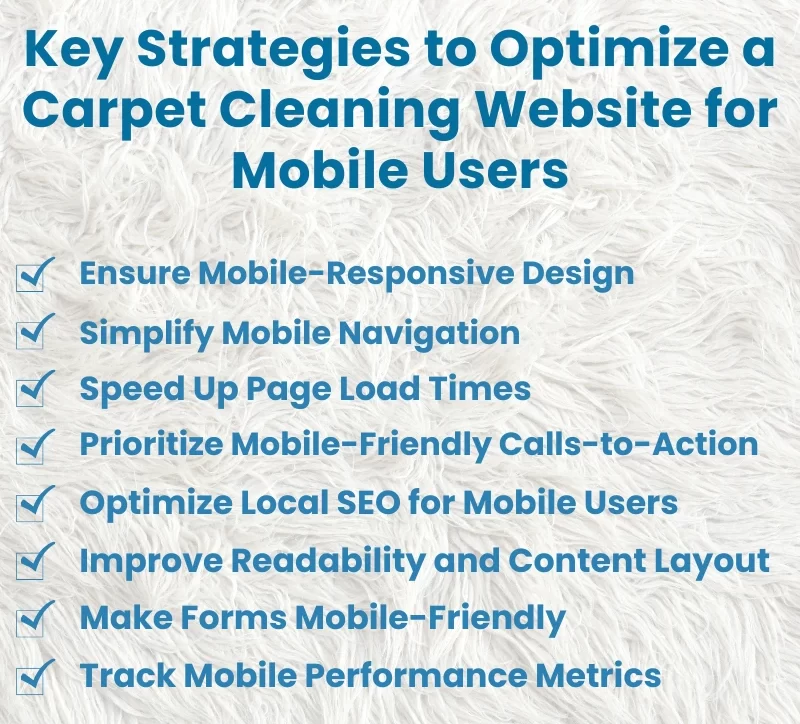Today, mobile traffic has overtaken desktop. For carpet cleaning businesses, this shift means your mobile site experience is no longer optional—it’s essential. Studies show that over 63% of organic search traffic in the U.S. comes from mobile devices
Potential clients searching “carpet cleaners near me” on their phones expect fast, clean, and intuitive mobile sites.
If your site takes too long to load or is hard to navigate, you’re handing leads to your competitors.
Below is a detailed guide to help you optimize a carpet cleaning website for mobile users, ensuring better user engagement, higher conversion rates, and improved SEO.
Key Strategies to Optimize a Carpet Cleaning Website for Mobile Users

1. Ensure Mobile-Responsive Design
A mobile-responsive design means your website automatically adjusts its layout based on screen size. This is fundamental to usability.
Best practices include:
- Use flexible grid layouts and scalable images.
- Avoid Flash or non-supported mobile elements.
- Test responsiveness across devices (phones, tablets, etc.).
Take a look at the table below for an overview of how responsiveness affects user engagement:
|
Device Type |
Bounce Rate (%) | Avg. Session Duration |
|
Desktop |
40% |
3m 20s |
| Mobile | 58% |
1m 45s |
Source: Contentsquare 2023 Digital Experience Benchmark Report
Mobile visitors are more likely to bounce if the site is not optimized. For a carpet cleaning business, this could mean losing customers who are ready to book on the spot.
2. Simplify Mobile Navigation
When someone lands on your site from a mobile device, they’re likely in a hurry. Complicated menus and small tap targets can frustrate them quickly.
Mobile navigation best practices:
- Use a collapsible hamburger menu to conserve space.
- Prioritize key pages: “Home,” “Our Services,” “Book Now,” and “Contact.”
- Avoid multi-level dropdowns.
- Use large, thumb-friendly buttons.
For example, if your menu contains redundant links or hidden services, simplify it so users can immediately reach key service pages, like “Carpet Steam Cleaning” or “Pet Odor Removal.”
3. Speed Up Page Load Times
Google research shows that 53% of mobile users abandon a site that takes longer than 3 seconds to load.
To improve speed:
- Compress image files without compromising quality.
- Use browser caching and lazy loading.
- Minify CSS, HTML, and JavaScript files.
- Choose fast, mobile-friendly hosting.
For carpet cleaning websites with service galleries and before-and-after photos, optimizing images can have a huge impact without degrading user experience.
4. Prioritize Mobile-Friendly Calls-to-Action (CTAs)
Your calls-to-action should be immediately visible and tappable.
Practical CTA placement tips:
- Use sticky “Call Now” or “Book Online” buttons.
- Place a CTA at the top of every mobile page.
- Make CTAs at least 44px by 44px (Apple’s recommended tap size).
For instance, a floating “Get a Free Estimate” button on mobile can significantly boost conversions for local services.
5. Optimize Local SEO for Mobile Users
Local searches are predominantly mobile. When users search for “carpet cleaning near me,” Google uses location and mobile-friendliness as ranking signals.
Local SEO tips:
- Use schema markup with your business name, address, and phone number.
- Ensure Google Business Profile is updated with mobile-friendly links.
- Include city and neighborhood names in page titles and meta descriptions.
- Use click-to-call links.
A local-optimized site not only helps Google understand your location but also makes it easier for users to act, like calling your business with a single tap.
Also Read- How to Write SEO Friendly Blog Posts for Carpet Cleaning Websites
6. Improve Readability and Content Layout
Reading long blocks of text on a mobile screen can be tiring. Structure your content for mobile consumption.
What to do:
- Use short paragraphs (2–3 sentences max).
- Break up content with bullet points and subheadings.
- Use legible fonts (at least 16px).
- Ensure high contrast between text and background.
Also, avoid pop-ups and interstitials that interrupt the user journey—Google penalizes them on mobile.
7. Make Forms Mobile-Friendly
Booking forms, contact forms, or quote requests must be simple and user-friendly.
Mobile form tips:
- Use autofill and input masks (e.g., phone numbers).
- Limit the number of fields (name, email, service type, preferred date).
- Stack form fields vertically.
- Use large, easy-to-tap submit buttons.
An overly complicated form on mobile often results in abandonment, costing you leads.
8. Track Mobile Performance Metrics
Once your site is optimized, monitor mobile traffic performance to continuously improve.
Tools to use:
- Google Analytics 4: Segment traffic by device type.
- Google Search Console: Check mobile usability reports.
- Hotjar or Clarity: Analyze how mobile users interact with your site.
These insights help you understand what’s working and where users might be dropping off.
Final Thoughts
With mobile devices driving the majority of local searches, optimizing your carpet cleaning website for mobile users is more important than ever.
Every second of page load time, every tap of a button, and every block of text affects whether a potential customer sticks around or bounces.
By combining responsive design, fast speeds, intuitive navigation, and smart local SEO, you don’t just improve rankings, you build trust and make it easier for people to choose your service.
Looking for help implementing mobile optimization strategies? Keep an eye on our blog for more actionable insights and guides tailored to the cleaning industry.

